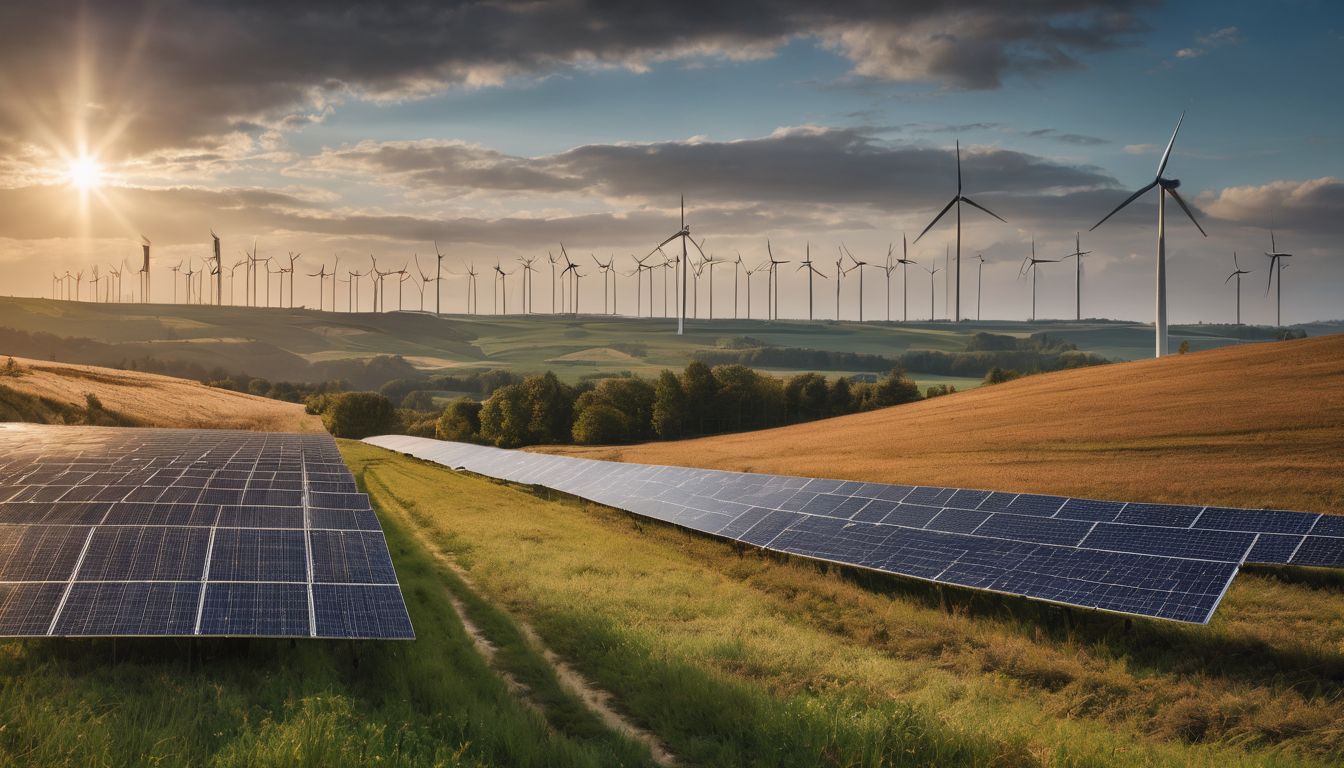Amidst rising energy bills and climate concerns, many in the UK are searching for sustainable power solutions. Hydroelectric power provides nearly 17% of the world’s electricity but remains a small player on Britain’s energy field.
This article explores hydroelectricity’s potential to revolutionise how we light our homes and fuel our industries, delving into its benefits and challenges in the UK context. Stay curious – will water be our next powerhouse?.
Key Takeaways
- Hydroelectric power is a clean and renewable energy source that can produce electricity without emitting greenhouse gases, offering environmental benefits.
- The UK government supports the expansion of hydropower with various initiatives and investments aimed at increasing efficiency and sustainability in the sector.
- Hydropower in the UK has untapped potential for growth, with opportunities to develop new practical and viable hydroelectric stations to meet future energy demands.
- Climate change presents challenges for hydropower generation, but ongoing research into new technologies aims to optimise energy output despite changing weather patterns.
- Existing hydropower schemes must adapt to climate impacts such as altered precipitation patterns and water availability to maintain consistent power production.
Understanding Hydropower
Hydropower is a renewable energy source that generates electricity by harnessing the power of flowing or falling water. It is cost-effective and environmentally friendly, making it an important part of the UK’s energy mix.
With various types of hydropower schemes in place, it plays a significant role in generating sustainable energy for the country.
How it works
Hydroelectric power harnesses the energy of moving water to generate electricity. Water from rivers or reservoirs flows through turbines in a dam, spinning them like giant fans. These turbines are connected to generators that convert this mechanical motion into electrical current, forming a renewable source of energy.
Dams store vast amounts of water at height creating potential energy; when released, it transforms into kinetic energy as it falls and moves the turbine blades. This efficient process captures natural force without emitting harmful pollutants, making hydroelectricity a cornerstone for sustainable energy strategies in the UK.
Moving on to the costs associated with this form of power will shed light on its economic viability.
Cost comparison
Having explored how hydropower functions, we now turn to its financial aspects. The cost comparison between hydropower and other energy sources is a crucial factor in understanding its place in the UK’s energy market. Consider the following table, which summarises the key cost factors:
| Energy Source | Initial Investment | Running Costs | Maintenance Costs | Average Lifespan |
|---|---|---|---|---|
| Hydroelectric | High | Low | Medium | 50-100 years |
| Wind | Medium | Low | Medium | 20-25 years |
| Solar PV | Medium | Very Low | Low | 25-30 years |
| Coal | Medium | High | High | 30-50 years |
| Nuclear | Very High | Low | High | 60-80 years |
| Gas | Low | High | Low | 20-30 years |
The table highlights that while hydroelectric power demands a significant initial investment, its operating costs rank among the lowest. Furthermore, its durability outstrips that of many other power sources. Building resilient and long-lasting power infrastructure aligns with the goals of conservationists and those advocating for environmental stewardship.
Current Hydropower usage in the UK
Hydropower currently accounts for around 1% of the UK’s electricity generation. Several small-scale hydroelectric power stations, mainly run-of-river schemes and a few large-scale installations operate across the country.
These include well-known sites like Dinorwig in Wales and Cruachan in Scotland. The government has been actively promoting further development of hydropower as part of its renewable energy strategy, aiming to increase the use of this clean energy source.
The UK has good potential for expanding hydropower usage, particularly through the construction of more pumped storage facilities. With an increasing focus on green energy and reducing carbon emissions, there is a growing interest in exploring new opportunities for harnessing water resources to meet future electricity demands.
Types of Hydropower schemes
Hydropower schemes come in various forms, including:
- Run-of-river systems – utilising natural water flow without a dam
- Reservoir systems – creating large artificial lakes to store water for power generation
- Pumped storage systems – using surplus energy to pump water back into a higher reservoir for later use
- Tidal hydropower – harnessing the energy of tides to generate electricity
- Offshore hydropower – capturing the power of ocean currents and waves for energy production
Advantages and Disadvantages of Hydropower
Hydropower offers a renewable and environmentally friendly energy source. It produces electricity without emitting greenhouse gases, making it a clean power option. Additionally, hydropower can provide continuous electricity supply, unlike solar or wind energy which is dependent on weather conditions.
However, the construction of large dams for hydropower plants can disrupt ecosystems and animal habitats. Furthermore, silt build-up behind dams can impact water quality and aquatic life downstream.
The advantages of hydropower include its low operating costs and long lifespan compared to other energy sources. Nonetheless, there are disadvantages such as potential environmental impact from dam construction and habitat disruption.
Potential for Growth in the UK
The UK still has a significant amount of untapped hydropower potential, with an estimated remaining viable capacity. Further practical and viable hydropower stations are also possible, supported by government initiatives and investments.
Estimated remaining viable potential
Hydropower in the UK has an estimated remaining viable potential that is currently being explored to expand renewable energy sources. Potential capacity for further practical and viable hydropower stations exists, providing a promising outlook for the future of hydropower in the country.
Government initiatives and investments are crucial components driving the development of more efficient hydroelectric power stations to meet growing energy demands sustainably.
Going forward, it’s essential to understand how climate change may impact these potential developments and how advancements in technology can help overcome these challenges. As we delve deeper into this exciting facet of renewable energy, it’s important to consider the impact of climate change on hydropower potential as well as its implications for future power generation.
Potential for further practical and viable hydropower stations
As the demand for renewable energy grows, there is vast potential for further practical and viable hydropower stations in the UK. With ongoing government initiatives and investments, there are opportunities to harness untapped hydropower resources across the country.
The estimated remaining viable potential indicates room for expansion, providing a promising outlook for the development of new hydroelectric power stations that can contribute to Britain’s renewable energy goals.
Looking forward, it’s essential to explore how these practical and viable hydropower stations can be integrated into existing infrastructure to maximise their benefits while minimising environmental impact.
By strategically locating new hydropower installations, we can ensure sustainable energy generation that complements other forms of renewable energy in the UK.
Government initiatives and investments
- Funding research and development projects to explore new technologies for efficient power generation.
- Providing financial incentives to encourage the establishment of new hydropower stations across the country.
- Partnering with private sector entities to advance the development of innovative pumped storage hydroelectric power projects.
- Implementing policies aimed at streamlining regulatory processes to facilitate quicker approval and construction of new hydroelectric projects.
- Collaborating with environmental organisations to ensure that hydropower developments are conducted sustainably, minimising impact on ecosystems and wildlife habitats.
- Offering grants and subsidies to support the retrofitting of existing infrastructure with modern, energy-efficient technologies.
Impact of Climate Change on Hydropower Potential
Climate change may significantly impact the potential for hydropower in the UK, affecting power generation and existing schemes. It is important to understand how climate change can affect the future of hydropower in the UK.
Changes in power generation
Hydropower generation faces challenges due to changes in weather patterns. As rainfall becomes more unpredictable, the overall water supply for hydropower could become less reliable.
This unpredictability impacts the consistency of electricity production from hydroelectric stations.
Operators are adapting by considering alternative power sources and investing in newer technologies to optimise energy output. With a focus on sustainable practices, these adjustments will help maintain a stable power grid amidst changing climate conditions.
Impact on existing hydropower schemes
Climate change poses a significant threat to existing hydropower schemes. Changes in precipitation patterns and water availability directly affect the ability of these schemes to generate power consistently.
Furthermore, higher temperatures can lead to increased evaporation rates, reducing the amount of water available for power generation.
The reliability and efficiency of existing hydropower stations are at risk due to climate change impacts such as extreme weather events and altered river flows. As a result, it is essential for operators to adapt and invest in technologies that can mitigate these effects and maintain consistent energy production.
Conclusion
In conclusion, the future of hydroelectric power in the UK looks promising. With growing potential for practical and viable hydropower stations, there is a steady opportunity for further development.
Government initiatives and investments are playing a crucial role in advancing the growth of hydropower in the country. The impact of climate change on hydropower potential will be a driving factor influencing advancements in this renewable energy source.
FAQs
1. What does the future look like for hydroelectric power in the UK?
The future of hydroelectric power in the UK seems promising, with energy research pointing towards further development of hydropower plants to enhance water energy usage and support UK energy production.
2. Are there new hydroelectric projects coming up in the UK?
Yes, there are new hydroelectric projects planned that aim to boost the potential for hydropower development and increase hydroelectricity generation across the region.
3. How might climate change affect hydropower potential in the UK?
Climate change could impact water levels which may alter how much energy is generated by existing and future hydroelectric power stations in the UK.
4. Is pumped storage a part of the UK’s hydropower plans?
Indeed, pumped storage hydroelectric power is an important component within the UK’s strategy for increasing energy security through reliable renewable sources.
5. Can hydropower contribute significantly to Britain’s overall energy needs?
Hydroelectric power has significant potential to help meet Britain’s demand for renewable energy as it continues to explore its full capacity within sustainable limits.





